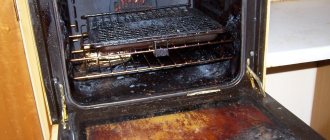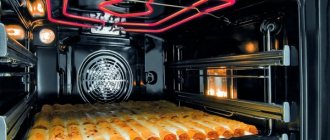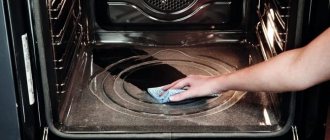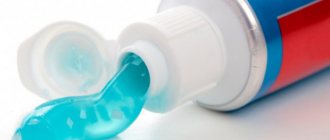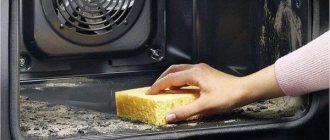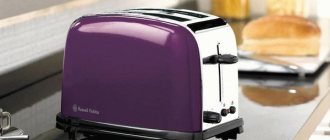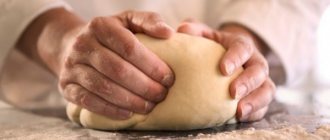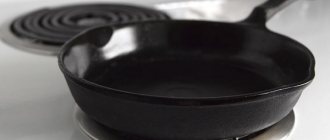05/01/2017 Maria Ivanova 2 comments
Raise your hands, who loves something baked: meat, fish, pies? Everyone loves it.
What if the oven is covered with a layer of nasty grease and smearing soot? We don't see a single hand. How to clean the oven from old burnt fat? We're willing to bet that many of you are now thinking, “I clean it, but it's still greasy. I heard that stoves are self-cleaning.”
Yes, there are such plates. But civilization reaches our native land only with difficulty, and most of the ovens we have at home do not have this ability. We'll have to use what we have in the kitchen (or what we can buy just across the street). Oddly enough, this should be enough.
Security measures
Remember that any cleaning product works because a chemical reaction occurs. Ignoring safety precautions can therefore end very badly.
Outsiders
First of all, remove children and pets from the kitchen. Children poke their noses into every crevice, toxic fumes can harm them, and there’s nothing to say about animals. It is a sin to poison our defenseless brothers with household chemicals.
Ventilation
The kitchen should be well ventilated - you also need to take care of your health. Open the window, or better yet, a window, if the weather permits.
Personal protection
You can be a smart person and think about the beauty of your nails. Any action should be carried out wearing rubber gloves.
To achieve the best results, before performing any action, read the instructions completely and make sure that everything needed to perform the action is available and ready for use.
This is necessary so as not to urgently run to the store for a new sponge when the time comes to wash off the product.
Precautions when cleaning the oven
When using any oven cleaning products, especially if they are household chemicals, it is recommended to take precautions, observing personal safety precautions:
- the room where cleaning will be carried out must be well ventilated;
- The presence of children in the room is not recommended;
- cleaning using products is carried out only with gloves to protect the skin;
- Do not apply the substance to heating elements; in case of contact, rinse thoroughly with water;
- try to avoid contact with the skin, especially the face and eyes. Otherwise, rinse carefully with clean water.
Taking good care of the oven will extend its service life for a longer period. If you get rid of traces of grease and soot in a timely manner, cleaning will be easy, without unnecessary effort, and the cooked food will have a pleasant aroma.
The article has been verified by the editors
Special cleaning agents: should I use them or not?
Cleans grease: yes.
Cleans soot: partially.
As they say, it’s a disaster when the cake maker starts making the boots, and the shoemaker starts baking the pies. If you don’t mind the money, preference, of course, should be given to store-bought chemicals.
It is also more gentle, as it is designed specifically for this type of work, and in some cases it cleans much better.
GreenClean, Mr. Muscle, the widely advertised Amway and the widely recommended Schumanite.
When wondering how to clean the oven from old grease, avoid products containing acid.
Amway Oven Cleaner
Expensive, but effective. Patented product for cleaning household ovens. Fat dissolves almost before your eyes and is well worth the money spent on it. Unfortunately, not everyone can afford it.
"Shumanit"
Bestseller. It’s a little cheaper than Amway’s product, but it cleans just as effectively—housewives couldn’t be happier. Sprayed on surfaces with burnt fat. A severe minus is the sharp, nasty smell, which, however, quickly disappears.
"Sillit Bang Antifat"
Cheap and cheerful. And when faced with such means, it’s worth thinking about: is it really possible to overpay for something that is much easier to make yourself from what is in every kitchen?
The composition of such products is suspicious, and in order to wash them off completely, you need to treat the surface with water more than seventy times. You don’t want to eat pies filled with suspicious chemicals, do you?
Review of Amway oven cleaner (Amway)
The stove cleaner from the American manufacturer Amway removes greasy stains of varying degrees of complexity well. Not suitable for aluminum, painted or chrome plated boards.
Main advantages:
- thick consistency;
- economical consumption;
- removes contaminants of varying degrees of complexity;
- no pungent odor.
When working, you need to apply a small amount of gel to the surface, spread and wait half an hour. The gel breaks down dirt, and you can easily wash off any remaining product.
When using a product for Faberlic or Amway slabs, it may be necessary to re-use it if the slab is heavily soiled. This is fine. Heavy contamination requires a lot of effort.
A little salt and the oven is clean
Cleans grease : yes.
Cleans soot : partially.
Yes, regular table salt. Cheap and cheerful. Cleaning the oven with salt at home can be done in two different ways.
First: cover the surface of the oven with salt and turn on the oven.
Check the appearance of the surface periodically: when the salt turns brown, turn off the oven, let it cool, then wash off the salt that has absorbed the fat. No harmful fumes or unpleasant odors.
Salt method number two involves placing a pan with a water solution of salt in the oven, turning on the stove and letting the water evaporate for a while.
Twenty minutes is usually enough. After this procedure, fat and soot are also easily washed off.
Rules for using folk remedies for cleaning
Problems with cleaning the oven arise due to changes in the properties of fat due to constant thermal influence, leading to the settling of stubborn carbon deposits on the walls of the oven. There are two ways to clean it:
- resort to using household chemicals;
- cleaning the oven using improvised and folk remedies.
When removing dirt from the stove, you should follow the following rules:
- Do not use products containing aggressive acid, as this may damage the material used to make the surface of the stove.
- If the tiles have a catalytic type of cleaning, it is not recommended to use detergents with active ingredients that lead to the destruction of the catalyst. With this function, the oven surface cleans itself and any remaining stains are removed with the next use.
- To make it easier to remove dirt from the oven, it is recommended to wipe the surface after each cooking. Fresh grease stains are easier to clean than old ones. If you rarely clean it, food debris embedded in the enamel can catch fire and smoke, giving off an unpleasant odor.
- After using household chemicals, you should thoroughly rinse the walls with warm water three times. This will help prevent chemical residues from getting into your food. When using folk remedies, it is enough to rinse once; the substances leave no traces and are harmless to food.
- Protect your hands by using rubber gloves.
- To facilitate cleaning procedures, it is recommended to preheat the oven to 100°C, this will help ensure better detachment of fat and soot from the walls.
- When cleaning, open the windows to ensure room ventilation.
- When using the heating method with the product, do not open the cabinet door, as you may get burned.
- Disconnect the stove from electricity when cleaning grease.
By following simple instructions, removing dirt at home will be easy.
How to quickly clean a gas stove with soda and vinegar?
Cleans fat : partially.
Cleans soot : yes.
A mixture of soda and vinegar produces a large amount of carbon dioxide (this is how the first artificially carbonated mineral water was made). Take care of your hands.
There is no point in preserving carbon deposits; we are going to destroy it. You can clean the oven from carbon deposits at home by adding twenty-five grams of laundry soap solution to a mixture of one hundred grams of soda with forty grams of vinegar.
This paste should be placed with a sponge on all surfaces of the oven, including glass, baking tray and rack, and left for a couple of hours, then go over them with a clean, damp sponge. You can then throw away the sponge and admire the shining oven.
There is another method: pour vinegar essence into a spray bottle, spray it on the surface of the oven, and then cover it with soda. In this case, you will have to wait only a quarter of an hour.
Soda and citric acid
Lemon acid will help get rid of not only plaque, but also foreign odors. Use a couple of bags of artificial “lemon” or lemon juice, add a little water and NaHCO3.
Recommended for you:
How to disinfect with caustic soda
This paste should be applied with a soft cloth. The remaining paste in a glass container at a temperature of 50°C is placed inside the oven for 30 minutes.
After cooling, the stove is washed with plain water. It is not advisable to apply the paste to glass surfaces so that abrasive particles do not leave scratches.
Clean the electric oven: Comet paste
Cleans grease : yes.
Cleans soot : yes.
To clean an electric oven at home, there is a special cleaning paste. Take citric acid, dishwashing detergent and cleaning powder a la Pemolux, Comet and the like. These components must be mixed in a one to one ratio.
Now, as in the case of the baking soda and vinegar paste, all surfaces must be exposed to the paste. Since the electric oven is more delicate, you should keep it covered with paste for no more than an hour. After the hour is up, you will need plenty of warm water to wash off the paste.
Which product to choose
You can wash kitchen utensils using chemical products. By type, ovens are divided into gas and electric. Cleaning the gas stove:
- Before cleaning, be sure to wear gloves;
- preheat the stove for 10 minutes at minimum temperature;
- dissolve the cleaning powder in a bowl of warm water;
- remove the greasy wire rack and baking sheet from the cabinet, place them in a bowl with a foam solution;
- Using a sponge, treat the entire middle of the stove with dishwashing liquid;
- Thoroughly wash away any remaining soapy liquid. Clean and rinse the baking tray with wire rack. Put it back in;
- Leave the cabinet door ajar for 24 hours to remove the smell of household chemicals.
We clean the electric stove from the old greasy layer:
- put on gloves;
- prepare a mixture that can be used to scrub off the greasy layer. Mix in equal parts: cleaning powder, dish liquid and citric acid;
- wet the sponge and start wiping off the dirt from the middle of the oven;
- Without rinsing off the cleaning mixture, let it sit for about an hour (if it is heavily soiled, the time should be increased);
- thoroughly rinse the oven walls with water, removing dirt and household chemical residues;
- Open the cabinet door slightly to ventilate.
Cleaning the oven from carbon deposits using natural home remedies is realistic and economical. All components are available in every housewife's cupboard; they act gently and effectively.
Lemon acid
You can clean the oven from the greasy layer using citric acid using the boiling method. To prepare the solution, fill a baking tray with water and add citric acid per 1 liter of water - 1 tsp/l of acid. Set the sensor to the 100-degree mark, boil the liquid for about 5 minutes. Turn it off and wait until it cools down. Clean dirty walls effortlessly. Everything will be washed away without a trace.
If lemon is not available, you can use lemon, per 1 liter of water - the squeezed juice of half the fruit. If the dirt is minor, rub the dirty surface with the prepared liquid. After 40 minutes, wipe off any remaining dirt and grease from the walls with a sponge. The product effectively removes dirt and unpleasant burning odor.
Vinegar
To clean the cabinet of grease, use undiluted 9% vinegar. You should put on gloves, rub the solution all over the oven walls, and leave for two hours. Rinse thoroughly with clean water. If the dirt is ingrained, the procedure should be repeated or the exposure time of the vinegar should be increased. The substance does not corrode the enamel coating and effectively cleans the walls.
Ammonia
There are two ways to clean using ammonia:
- Before going to bed, treat the cabinet walls with ammonia using a sponge or cloth. Leave to work overnight with the door tightly closed. In the morning, thoroughly rinse off the alcohol along with any remaining dirt.
- Make a solution of ammonia and water 1:4. Place in a preheated oven for 3-4 hours. Wait until it cools completely and clean off any dirt.
Laundry soap
To clean the cabinet, use a piece of laundry soap. To prepare the product, grate half a piece and dissolve in two liters of liquid. Preheat the oven to 150 degrees, boil the liquid for about 45 minutes. The gentle action of a soap solution softens the old layer of fat and carbon deposits. To get rid of soapy smell, wash the walls thoroughly with clean water.
The easiest method is to clean kitchen utensils with steam. You will need a bowl of water, you can use a baking sheet. Preheat the oven to 100 degrees, boil water for about 45 minutes, add water if necessary. For an enhanced effect, add a couple of drops of dishwashing detergent. Once cool, wipe off the grease layer with cleaning powder.
How to easily clean the oven with hydrogen peroxide?
Cleans grease : yes.
Cleans soot : yes.
We prepare porridge from hydrogen peroxide (sold at the pharmacy) and a quarter glass of soda. Everything must be mixed well and applied to greasy surfaces.
If you overdid it with volumes and some amount of soda-peroxide porridge remains, you can also clean the grease from the glass and grate. Leave for an hour. Don’t forget to completely remove it with a sponge dipped in soapy water and wipe dry.
How to clean the oven: vinegar and soda
You can clean the cabinet of grease and carbon deposits using sodium bicarbonate and vinegar. The chemical formula obtained by the interaction of ingredients easily copes with old stains.
The stages of work are as follows:
- The surfaces inside are wiped with foam rubber soaked in vinegar. It is better for the housewife to wear gloves to protect her skin.
- After this, baking soda is poured onto the same foam rubber, which should be applied to the problem area. A thin layer of NaHCO3 is also applied to the open door.
- After three hours, the powder is removed with a rag. Surfaces are washed and dried.
The recipe is as convenient as possible for cleaning an electric stove; sodium bicarbonate is an exceptionally soft abrasive and does not harm surfaces.
How to clean the oven from old grease with ammonia?
Cleans grease : yes.
Cleans soot : yes.
A universal method to clean the oven from burnt fat.
Ammonia - a solution of ammonia in water - emits a terrible odor that can be used to revive someone from fainting. Ammonia itself belongs to the group of asphyxiating substances. To use this magical remedy, you will have to purchase a respirator if you value life and health.
You need to open all windows, treat contaminated surfaces with ammonia and leave for four to five hours, then rinse.
After wiping the oven with ammonia, it must be thoroughly rinsed several times until the smell disappears, otherwise ammonia will get into the food. In this case, it is not dangerous, but very unpleasant.
How to make your own all-purpose cleaner
You can remove dirt from the walls of the oven with a homemade product made from several components.
| No. | Compound | Application |
| 1. |
| After mixing the ingredients until smooth, preheat the oven to 100 degrees and apply the mixture to the walls. Let it sit for 20 minutes. Rinse thoroughly with clean warm water. |
| 2 |
| After mixing all the ingredients until smooth, apply to the oven walls. Leave the substance to act for about two hours. Wash the walls from any remaining mixture, dirt, or grease. If necessary, extend the time the mixture remains on the dirt. Open the door slightly to ventilate the smell. |
The following methods will help eliminate unpleasant odors in the oven after cooking various dishes:
- To get rid of the aroma of burnt food, you can use the peel of any citrus fruit. To do this, place the skins on a baking sheet and heat until a characteristic aroma appears. Or rub the sides of the cabinet with a lemon slice.
- If there is burnt liquid or stain left on the surfaces, you can sprinkle with salt. This will help avoid unpleasant odors during cooking and make cleaning easier after cooking.
- Use of sorbents: coffee and soda. It is recommended to pour the sorbent into a saucer and put it in the oven. They will absorb all unpleasant odors.
On a note
- If the smell remains, dilute 12 tablets of activated carbon in a glass of water and place them inside. Charcoal will remove unnecessary aromas.
- Do not rub heat-resistant glass with a tin brush. Otherwise, it will remain damaged.
- Before cleaning, remove everything from the oven: baking sheet, racks and other components.
- Wipe the inside with a clean cloth after each cooking. Then you won’t have to clean out old contaminants.
- Take precautions when handling. This way you will protect your health and the health of others.
Cleaning instructions
There are two methods to clean the oven with ammonia. The first is to apply the product to the dirt inside using a sponge. The liquid is left on the walls for 10 hours, then the carbon deposits and grease are washed off with water. The main condition is to close the oven door and open the windows. The product stinks and can cause an allergic reaction in apartment residents.
Step-by-step description of the second method:
- Boiling water and ammonia are poured into two containers with the same volume.
- We place the chemical on the top shelf in a heated roasting pan, and the water on the bottom.
- Boil the water inside for five minutes.
- Leave the liquid for 5 hours.
- Open the door and use a sponge to remove the fat.
- We wash the walls with warm water.
Manufacturers add ammonia when making new cleaning products. Ammonia removes grease stains, carbon deposits and adds shine to metal, glass, ceramic and jewelry.
Cleaning the oven with ammonia
A popular home method to get rid of dirt in the oven without using store-bought chemicals. Ammonia is good at removing old burnt-on fat and will help clean the walls of soot. The only negative is that it takes about 10 hours to clean an electric oven. You will need 2 deep glass plates, boiling water, 200 ml of ammonia. First, preheat the oven to 60 degrees and turn it off. Pour half a liter of boiling water into one container and place it on the lower tier of the oven. Pour alcohol into the second container and place it on the middle tier. Close the door and leave for 9-10 hours. Next we remove all fat deposits. After cleaning, you should ventilate the oven for several hours.
Cleaning the oven with steam
Steam cleaning or hydrolysis cleaning is the easiest way to clean cabinet walls and interior glass. This method allows you to quickly deal with light and medium stains. You can clean your oven with steam in two ways - with or without a steam generator. For the method without a steam generator, we need a baking tray, water, soap or dishwashing liquid. Place the baking sheet with the solution in the oven and heat it to 200 degrees. When heated, the soap solution turns into steam and settles on the walls and glass. Leave the oven running for 15-20 minutes, turn it off and wait until the temperature drops below 50 degrees. We remove dirt stains from the walls with a soft cloth. Thanks to the steam, dirt can be easily wiped off. When using a steam generator, you need to pour water into it and select a suitable nozzle, for example, according to the type of tube. Treat walls and old stains with steam. Then use a sponge to remove the dirt.
Modern ovens, such as Hephaestus, Bosh, Electrolux, Hansa, have a built-in steam cleaning function. When it is turned on, the oven independently regulates the temperature and operating time; after a sound signal, you can open the door and wipe the walls. Typically, in such models, water is poured into the bottom of the oven.
How to clean a baking sheet from the oven
Cleaning the baking sheet will not be difficult for you. In most cases, it is enough to simply soak it in a hot soapy solution and remove any remaining dirt with a sponge. Another way is to wash the baking sheet in the dishwasher if it fits in it.
If the baking sheet is old and the dirt cannot be washed off, the heating method will come to the rescue: fill the baking sheet with soapy water, put it in the oven at 120-150 degrees for 10-15 minutes. Once the pan has boiled, it will be easy to clean. For complex stains, additionally use special compositions for cleaning ovens.
Basic rules for cleaning the oven from burnt fat
A few simple rules will help to significantly simplify the cleaning process and increase its efficiency.
- Do not “start” the equipment. In order not to one day discover a thick, dark, unpleasant-smelling coating on the walls of the oven, you need to wipe the oven after each use. In addition, once a month a general cleaning of the oven, for example, with soda and vinegar, will not hurt.
- It is easier to remove grease and soot from a warm surface, so it is recommended to warm it up before washing the oven. To do this, just turn on the oven, set the temperature to 50°C, and leave for 20 minutes. You should not heat the cabinet too much in the hope that it will be easier to clean - the temperature inside should be comfortable for your hands.
- Before cleaning, you must remove the baking sheets and racks for free access to the entire surface of the oven.
- Regardless of the internal coating, it should not be washed with abrasive materials or wire brushes. Use a soft cloth or sponge.
- Do not apply cleaning agents to the fan or heating elements of the oven.
- After cleaning the oven, leave the door open to allow it to dry and ventilate.
Note! Using a lid, foil, or special bags (sleeves) when preparing food will significantly reduce the formation of fatty deposits on the inner surface of the cabinet.
